Heavy Laughter in Lean Years: 4 Short Comedies from Hal Roach Studios
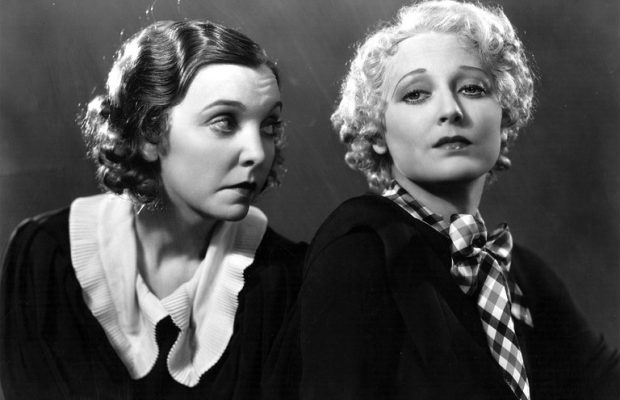
Toronto Film Society presented Heavy Laughter in Lean Years: 4 Short Comedies from Hal Roach Studios (1929-1933) on Sunday, December 16, 2018 in a double bill with The Conquerors as part of the Season 71 Sunday Afternoon Special Screening #6.
It’s easy to go the Hollywood Babylon route—dwelling on letdowns, scandals, and tragedies—with the cast and crew of the Hal Roach shorts we’re about to watch. So, before the laughs, here’s the eulogy. Max Davidson had already been demoted from his own starring series when he headlined the cast of Hurdy Gurdy, the first all-talkie Roach film. All he had to look forward to were a few charitably-given uncredited roles and a lonely bachelor’s life in a boarding house in Hollywood. A friendly neighbor described him: “He was a crusty little guy, short-tempered, prejudiced, narrow-minded, suspicious and, let’s face it, stingy. But he was indomitable… He never gave up on the picture business, even long after it had given him up.” That stinginess paid off in that he was at least able to live comfortably in retirement.
Charley Chase’s brother James Parrott, who directed One of the Smiths, died of an apparent suicide at the age of 41. His life had its bright moments—he had a decent acting career in some early 1920s Hal Roach films and he went on to be one of the best directors at the studio. One of his Laurel and Hardy films, the immortal classic The Music Box, even won an Academy Award. But a debilitating drug addiction sent his life into a spiral. His big brother supported him financially during these times but eventually he had to cut him off. Charley died five years later—prematurely gray and emaciated from alcoholism at 46. He had never forgiven himself for his brother’s death.
Thelma Todd’s body was found slumped across the front seat of her car, the garage a carbon monoxide gas chamber. She was not even thirty years old. The LA Homicide Bureau concluded that it was “accidental with possible suicide tendencies.” Some contend it was murder. Either way, it was even then a familiar tale of the Hollywood dream turned nightmare.
There’s a movie coming out very soon about the twilight years of Laurel and Hardy with Steve Coogan and John C. Reilly mostly dealing with the duo’s last attempt in show business touring in regional theaters of England. The glory days of the Hal Roach days were long gone but they’re chemistry was intact, and the tour ended up being a bittersweet final triumph. Run of the mill addiction—namely cigarette smoking—can be blamed on their deaths. Oliver died at 65, Stan at 74.
But let’s not dwell too long on these matters, Stan did issue a warning: “If anyone at my funeral has a long face, I’ll never speak to him again!”
As we all know, the safest place to be is behind the camera. The proof: Hal Roach lived to be a centenarian. At the age of 100, a Washington Post reporter asked what was the key to his longevity.
Roach said, “What?”
Roach’s friend interjected, “Onions!”
Roach says, “Onions?”
“Yeah, you eat raw onions all the time.”
Hal conceded, “I like raw onions, and I eat a lot of them…but I mean, never enough to keep me alive to be a hundred.”
Like the raw onion-theory, perhaps these movies will keep you young even if you have tears in your eyes.
Introduction by Adam Williams
Hal Roach Studios: An Introduction
By the tail end of the 1920s, the major players of the Hollywood studio system had staked their territory and mobilized to control every aspect of their product; massive studio lots were constructed, stars were placed under contract, distribution was coordinated, and even the individual theatres were owned by one of the “big 5” (Paramount, Loew’s-MGM, Warner Bros., Fox, and the newly-formed RKO). Every step of the process—from the first draft of the screenwriter’s typewriter to the flickering image on the release print—was scrutinized by the money men. This set-up, known as vertical integration, would ultimately be deemed an oligopoly by the U.S. Supreme Court in 1948; but during “the golden age”, the system was airtight. Well, almost airtight. There were a handful of little studios that responded to the market for shorts to be shown prior to the feature film. Although most cities’ upscale movie houses featured live vaudeville performers prior to the feature, most neighbourhood theatres would lead off the night’s entertainment with a cartoon; a newsreel or travelogue; and a two-reel comedy, before the studio-produced, full-length film. For a brief few years, a handful of independent studios existed to fill these slim opening slots. Of these studios, Hal Roach’s left the most indelible mark on film history.
In the days right before Manifest Destiny had manifestly been ended, Hal Roach heeded Horace Greeley’s apocryphal advice: “Go west, young man!” Unsuccessful gold prospecting, mule skinning, construction work, and a stint as an extra in cowboy movies were a few of the picturesque occupations that this 20-year-old Elmira, New York native found in the rugged West. But his days in menial day-work would be short-lived. A hefty inheritance cheque was the kindling needed to spur Roach’s entrepreneurial spirit—in 1914, he founded the Rolin Film Company with partner Dan Linthicum. (“Rolin” being an amalgamation of their last names.) Making their mark with burgeoning star Harold Lloyd (who would eventually rise to the superstar ranks of Charlie Chaplin and Buster Keaton), the company toiled in the field of one-reel slapstick comedy with occasional forays into westerns and serials.
A couple of things would come to pass that changed Roach’s stature in the industry. In 1919, he broke ground on a tract of land in Culver City where he would construct his own studio; this would, after an amicable dissolution with his partner, be christened the Hal E. Roach Studios. There were some hiccups in the grand design: the remote locale lacked telephone service; the electric service was prone to frequent outages; and a couple of the studio’s stages were condemned by the city as unsafe for humans. Nevertheless, the productions increased in quantity and quality with the old standbys: Lloyd (who introduced his definitive character, the All-American boy with round glasses) and the dependable Snub Pollard. New into the fold were: multi-talented actor/director Charles Parrott (with his snappy yet hapless on-camera persona, Jimmy Jump, which evolved into the wildly popular Charley Chase); former English vaudevillian Stan Laurel; and Georgia-born Oliver Norvell Hardy, who had been making his hay as a movie heavy since 1914.
The least known of Roach’s stars today is German Jewish immigrant Max Davidson, who led his own series of “Dialect Comedies”; he most certainly deserves a tribute of his own. Roach’s female teams are hysterical: the pairing of statuesque Anita Garvin with diminutive Marion Byron and dazzling Thelma Todd partnered with the worrier queen ZaSu Pitts (who eventually bowed out to be replaced by Patsy “Queen of Wisecracks” Kelly). But trumping all these talents were a bunch of ragamuffin kids. In 1922, after observing a pack of neighbourhood children fighting over a stick with life-or-death passion, Roach had the idea of forming a troupe of tykes—not prissy and prim mini-adults coached to mechanical perfection by overbearing parents, but spunky, dirt-faced, and creative kids. Our Gang would be his longest-running, highest-earning, and most culturally enduring series.
The most significant factor to Roach’s ascent was that in 1927, he switched distributors from the relatively tiny and poor Pathé to the mighty MGM. With Leo the Lion in the credits of Roach’s comedies, he finally guaranteed some financial security and a wider audience. By all accounts, these were halcyon days at the studio—the cast and crew had upward and lateral mobility (actors would direct; gag writers would act). Family and friends of cast and crew could even mill about as extras. Director Gordon Douglas started as an office boy at Roach Studios, as a teen. Speaking with Leonard Maltin late in his life, he recalled, “Everybody was there to make the picture as good and as fast as possible, and as funny.” He went on, “I’ve never run into as many nice people in one spot as existed at Hal Roach.” This good-natured, collaborative spirit is reflected in the films themselves. While these two-reelers certainly revel in slapstick, there is a decidedly non-sadistic bent to the humour—nobody is immune from indignity. Nowhere is this more evident than in the ultimate in comedy teams, Laurel and Hardy. Roach had the great fortune to have both gentlemen on his roster, but it was his brilliant intuition that paired these two disparate persons, both in body and personality, to generate enough bursts of laughter to knock the earth out of orbit. The Poles knew them as Flip i Flap; Serbs called them Stanlio i Olio; and the Danish referred to the duo as Gøg og Gokke. Germans fell in liebe over Dick und Doof. There is a universal appeal to the two tenets governing The Boys’ films: a pie in the face begets the reciprocal and, to borrow the Yiddish proverb, “Man Plans, God Laughs.” In other words, while we both administer and receive human justice, our fate rests in the hand of a greater power—and He’s a real wise guy!
Roach produced reels upon reels of manic during The Great Depression, and it’s highly likely some of these antics saved a few lost souls from the depths of despair. While the country suffered, Roach and company offered a respite from reality in the form of a fun house mirror. The often-shabby productions were rife with characters just scraping by, laughing to keep from crying, and, without becoming mawkish, banding together in inseparable units. Hardy needed Laurel like Thelma needed ZaSu; papa Max Davidson loved his family; and the Gang was nothing if not loyal. But in real life, the studio was in a tenuous situation. On a high level, they were dependent on the studios maintaining two-reelers as part of the standard program, and, more specifically, they were wholly reliant on MGM’s powerful distribution.
By the second half of the 1930s, the major studios settled on the double-bill as the predominate program structure, relegating the shorts package program to the dustbin of time. MGM and Roach would soon part ways. Roach’s raison d’être—the perfectly paced, 20-minute comedy—would not be in demand for the foreseeable future (that is, until television arrived and made the sitcom an institution). This afternoon’s films are from the peak of Roach Studio’s creative and financial powers, all playing in theatres coast to coast. Despite being throwaway entertainment with none of the pomp and sheen of the feature films of the day, the best of these shorts is made with tremendous heart and energy.
The years leading up to the dissolution of the company and the demolition of the Culver City “Lot of Fun” in 1963 would see more downs than ups. Roach produced about three dozen feature films (and several “streamliners”—his attempt to kickstart a demand for 45-minute films), including the 1939 Of Mice and Men, one of his works to receive the greatest critical acclaim. This was especially satisfying considering just two years earlier, he had clumsily and ill-advisedly agreed to collaborate with Vittorio Mussolini (son of Il Duce) on a series of opera shorts. This deal, which was moribund a week after announcement, was an expensive and embarrassing mistake with the European countries inexorably leading to a war in which the American producer would soon be involved. Roach, although already 50 years of age, would dutifully serve in the Signal Corps. With his studio floundering during the war years, Roach, in the end, returned to an industry that had no room for the little guy. The Roach Studios would eventually convert to television production where, although production increased, profits dwindled.
Hal Jr. took over in the final years of the studio, but when the coffers ran dry, the giant playhouse where Laurel and Hardy, Our Gang, et al. had created glorious frivolities was demolished by war surplus tanks. Rather than mourn, perhaps it is healthier to imagine this sad scene as a Roach two-reeler. The final shot: Amid the dust and debris of the studio, the hatch of the tank opens and Stan Laurel’s tight-lipped, broad-grinning, mischievous face pops out. An unseen, but familiar, voice shouts from within the massive machine, “Why don’t you be more careful!” Suddenly, Mr. Laurel is yanked back into the tank and lumbering out of the hatch comes Ollie, his deadpan face staring imploringly into the camera. The End.
Short Film #1: HURDY GURDY • 1929 (20 min.) USA (b&w)
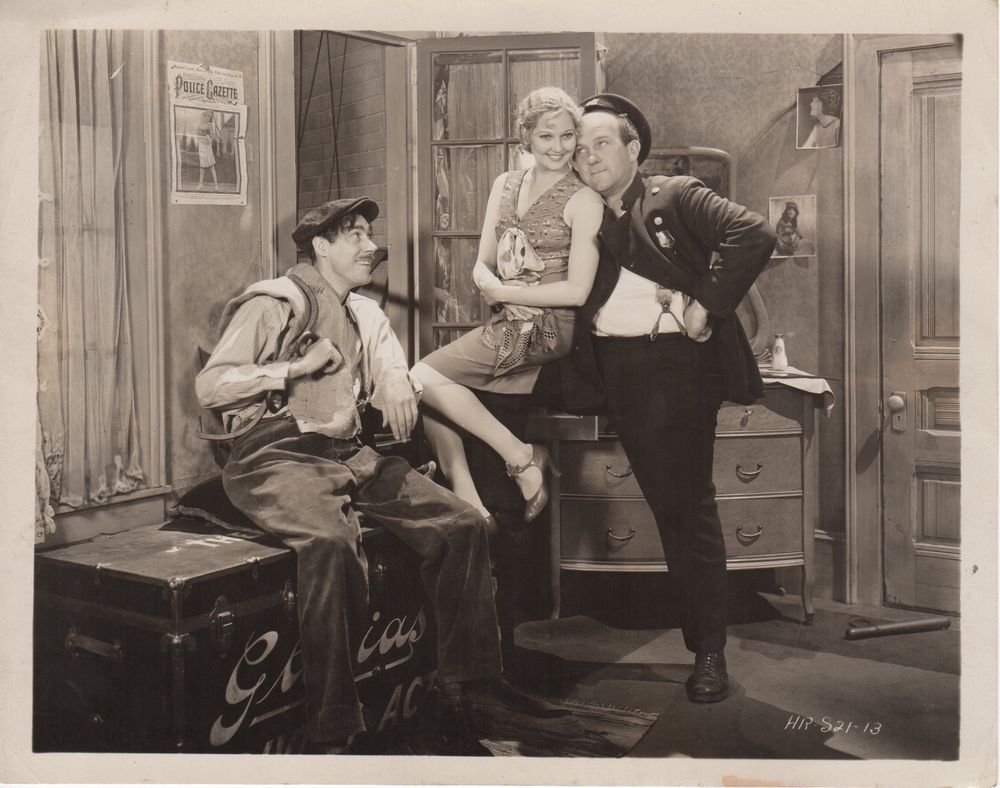
Production Company: Hal Roach Studios. Producer & Director: Hal Roach. Story: Leo McCarey. Cinematography: George Stevens. Film Editing: Richard C. Currier. Sound: Elmer Raguse. Release Date: May 11, 1929.
Cast: Max Davidson (Papa Ginsberg), Ann Brody (Mama Ginsberg), Edgar Kennedy (Officer Ed Kennedy), Nellie V. Nichols (Mrs. Nellie Kennedy), Gertrude (“Gertie”) Messinger (Kennedy’s Daughter), Oscar Apfel (Mr. Schnitzmeyer), Aileen Carlyle (Mrs. Schnitzmeyer), Thelma Todd (Blondie), Eddie Dunn (Ice Man), May Milloy (Italian Neighbour), Tony Campanaro (Hurdy Gurdy Man).
“America is God’s Crucible, the great Melting-Pot where all the races of Europe are melting and reforming…. Germans and Frenchmen, Irishmen and Englishmen, Jews and Russians—into the Crucible with you all! God is making the American.” – Israel Zangwill, in his play The Melting Pot (1909).
Scene: New York City, a tenement building on a sweltering summer day. The temperature is certainly set to high, but if this city is supposed to be a melting pot, as Zangwill’s play famously spoke of, the cultures don’t seem to be combining at all. Germans, Irish, Jews, and Italians are all out on their separate balconies generally having a really bad time. The iceman cometh, delivering a giant cube to the hot blonde number; oddly, the second delivery of the day. This film teaches us there are two subjects that cross all cultural divides: complaining about the weather and, more importantly, juicy gossip. Oh, the humidity!
The Cast:
Many of the Max Davidson-starring shorts for Hal Roach are now considered lost, but what remains is worth its weight in gelt. The demand for his brand of comedy rapidly vanished through the course of the 1930s. Unsubstantiated stories suggest that he was essentially blacklisted for playing up Jewish stereotypes in an unsavoury manner. If true, it’s a real loss—at 5’ 5” (factoring in the hair), this bearded titan steals the show with a surprising combination of distress and tenderness.
It’s a testament to Thelma Todd’s comic ability that her uproarious work at Hal Roach Studios carries with it not a trace of the tragedy that would soon befall her. A former schoolteacher and Miss America contestant, on-screen Todd appeared neither as a schoolmarm nor a glamour queen. Rather, she brought a breezy vitality and a fearlessness in appearing all-too-human throughout her appearances in the films of Laurel and Hardy and Charley Chase, and especially with her partners ZaSu Pitts and, later, Patsy Kelly. The circumstances around her death at the age of 29 in 1935 remain mysterious.
How do you make an Irish cop angry? Well, I’m not sure, but I’d suggest looking at several Edgar Kennedy movies for ideas. Known as the “King of the Slow Burn,” former-pugilist Edgar Kennedy was the quintessential harried cop (and/or father). He was a Hal Roach staple until he moved over to RKO to head his own series of shorts. Brooklyn-native Eddie Dunn appeared in around four hundred uncredited walk-on roles, from 1915 until his death in 1951. At Roach Studios, he rose from the ranks of bit actor/gagman to his only stints as director/co-director in several shorts from the 1934 season, including—get this—Charley Chase’s comedy The Cracked Ice Man.
Born in 1878, Clevelander Oscar Apfel was already a writer, producer, and director of over one hundred films (including some Cecil B. DeMille collaborations) by the time he had turned his attention fully to acting for the remainder of his career. Hurdy Gurdy was his first film for Roach, but he would go on to appear in a few more: one Our Gang; a couple of Charley Chase’s; and one from the short-lived Irvin S. Cobb series. Former Vitagraph Co. player Ann Brody had been in pictures since 1915. With her Polish accent and sympathetic demeanor, she specialized in playing old-world matriarchs. Gertrude Messinger was a star in another of Roach’s less-successful series, The Boy Friends—in a nutshell, Our Gang for the teenage set. Seven of The Boy Friends films were directed by George Stevens (Shane; A Place in the Sun).
Short Film #2: ONE OF THE SMITHS • 1931 (28 min.) USA (b&w)
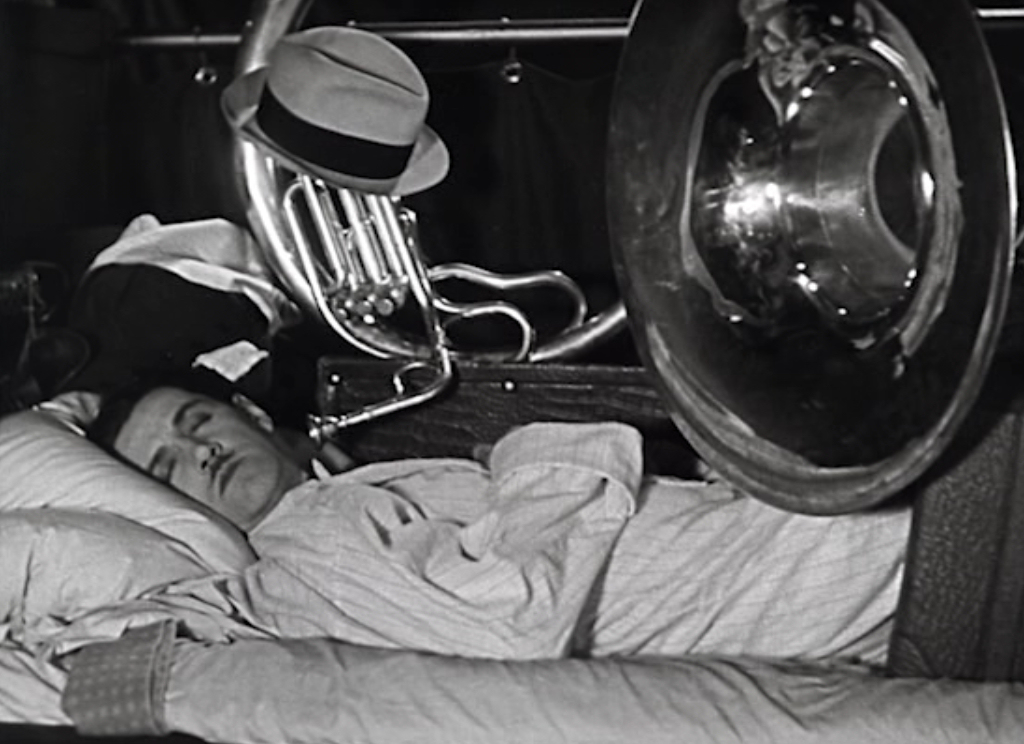
Production Company: Hal Roach Studios. Producer: Hal Roach. Director: James Parrott. Writer: H.M. Walker (Dialogue). Cinematography: Art Lloyd. Film Editing: Richard C. Currier. Sound: Elmer Raguse. Music: Leroy Shield (Composer, stock music). Release Date: May 23, 1931.
Cast: Charley Chase (Charley), James Finlayson, Louise Carver, Leo Willis, Harry Bowen, Eddie Baker, Harry Bernard, Jimmie Adams, Dick Gilbert (Townsman), Max Davidson, Chet Brandenburg (Upper Berth Passenger/Townsman), Ed Brandenburg (Townsman), Charles Dorety (Townsman Dancing with Sally), Charley Hall (Townsman), Jack Hill (Townsman), Peggy Howard (Sally), Buddy McDonald (Boy), William J. O’Brien (Upper Berth Passenger), Lyle Tayo (Sleepy Passenger), S.D. Wilcox (Chairman of the Board), Spencer Williams (Porter).
In the early 1930s, the increasingly modernized world became fixated with barefooted, corn cob pipe-smoking, square-dancing hillbillies. The Carter Family and Jimmie Rodgers brought country music to the masses via tours and records; William Faulkner published the controversial Sanctuary; and Erskine Caldwell countered with the even more controversial Tobacco Road and God’s Little Acre. It was a milieu ripe with comic possibilities, but before Li’l Abner and the denizens of Dogpatch sprung from Al Capp’s mind (inspired by seeing a hillbilly vaudeville act billed as “The Feudin’ Mountaineers”), Charley Chase made One of the Smiths for Hal Roach. This was made in a period when Chase was allowing his comedy some room to breath by incorporating songs and expanding the length to three reels. His musical interlude here—performing his own composition “Handsome Jim” as seen through the kaleidoscopic eyes of a drunkard—is the highlight. Direction is by Charley’s younger brother, James, who had been with the studio since 1917. In a short time, he rose from extra to star performer (with the alternative screen name Paul Parrott—“The Doodlewit of Screen Comedy”) to director (helming the Oscar-winning Laurel and Hardy short, The Music Box). But life was exceptionally difficult for the scrappy kid from Baltimore. Despite his epilepsy, he was drafted to fight in World War I, where he was soon wounded. Just like his brother, he was a heavy drinker, but he also became dependent on hard drugs, which led to his death at 41 years of age.
Short Film #3: ONE GOOD TURN • 1931 (20 min.) USA (b&w)
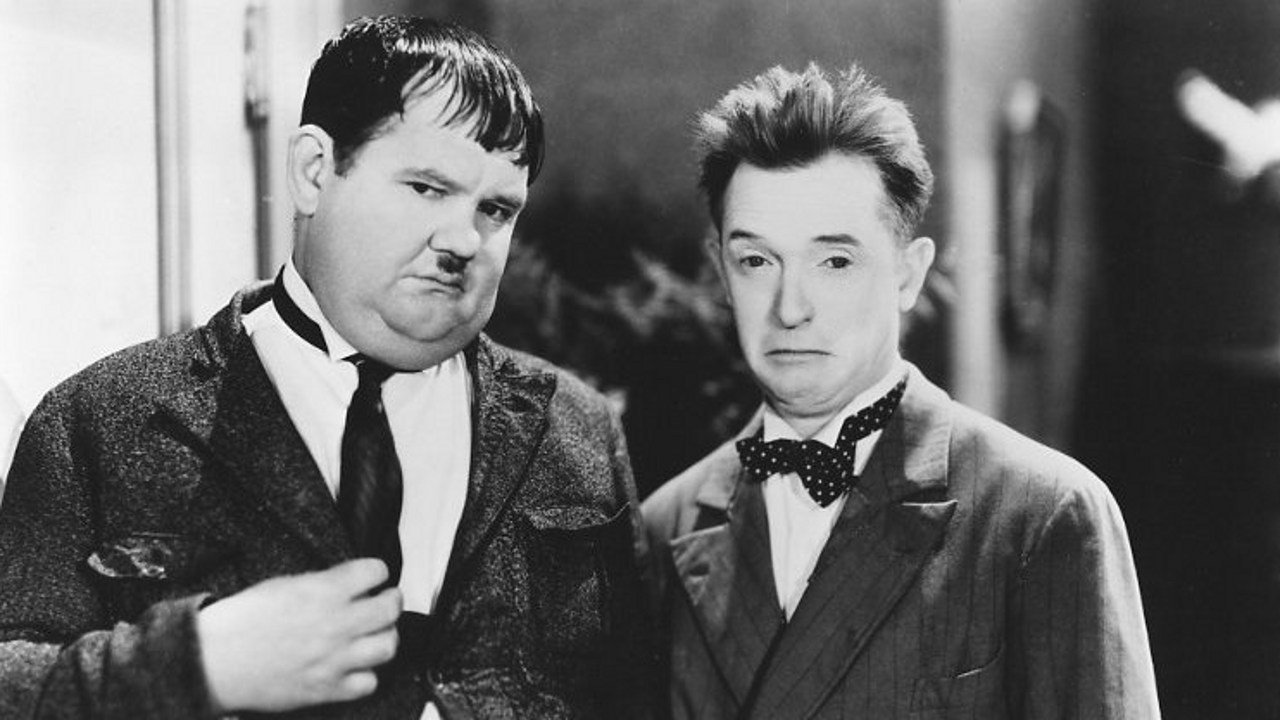
Production Company: Hal Roach Studios. Producer: Hal Roach. Director: James W. Horne. Writer: H.M. Walker (Dialogue). Cinematography: Art Lloyd. Film Editing: Richard C. Currier. Sound: Elmer Raguse. Music: Marvin Hatley (Composer, stock music), Leroy Shield (Composer, stock music). Presenter: Hal Roach. Release Date: October 31, 1931.
Cast: Stan Laurel (Stan), Oliver Hardy (Ollie), Mary Carr (Old Lady), Billy Gilbert (Drunk), “Snub” Pollard (A Community Player), James Finlayson (A Community Player), Baldwin Cooke (Bit Part), Gordon Douglas (A Community Player), Dick Gilbert (Bit Part), William Gillespie (Bit Part), Dorothy Granger (A Community Player), Ham Kinsey (Bit Part), Retta Palmer (Bit Part), Lyle Tayo (A Community Player), Charley Young (Bit Part).
During his tenure as film critic, Graham Greene confessed to his heretical preference of Laurel and Hardy over the canonical works of Charlie Chaplin: “…Their clowning is purer; they aren’t out to better an unbetterable world; they’ve never wanted to play Hamlet.” This complete lack of pretentiousness is never more evident than in Hardy’s delivery of his beggar’s spiel in One Good Turn, which begins, “Pardon the intrusion, but my friend and I are victims of the Depression….”
Short Film #4: ASLEEP IN THE FEET • 1933 (19 min.) USA (b&w)
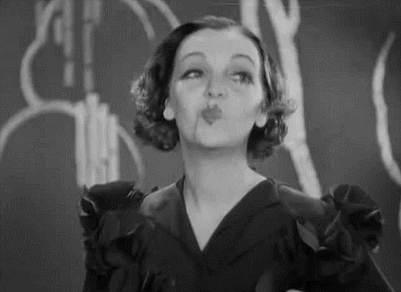
Production Company: Hal Roach Studios. Producer: Hal Roach. Director: Gus Meins. Cinematography: Art Lloyd. Film Editing: Louis McManus. Casting: Lawrence Tarver. Sound: James Greene. Music: Leroy Shield (Composer, stock music). Presenter: Hal Roach. Release Date: January 21, 1933.
Cast: ZaSu Pitts (ZaSu), Thelma Todd (Thelma), Billy Gilbert (Mr. Gilbert, Dance Hall Proprietor), Eddie Dunn (Sailor), Anita Garvin (Dance Hall Hostess), Nora Cecil (Female Police Officer), Nelson McDowell (Male Police Officer), Charles Dorety (Dance Hall Patron), Julia Griffith (Female Police Officer), Jack Hill (Dance Hall Patron), Frank Jenks (Dance Hall Patron), Kay Lavelle (Landlady), Tiny Ward (Dance Hall Patron).
Broke, tired, and hungry, Anita and ZaSu learn the hard way what Ruth Etting meant in ‘Ten Cents a Dance’: “Fighters and sailors and bowlegged tailors / can pay for their ticket and rent me! / Butchers and barbers and rats from the harbors / are sweethearts my good luck has sent me.” Anita fights off a Navy man (“Nautical, but nice!”) while ZaSu does her most convincing “boop-oop-a-doop” to allure nothing more than a veritable parade of freaks. In supporting roles are Anita Garvin, Eddie Dunn, Nelson McDowell (whose stern face made scores of westerns even more rugged), and Billy Gilbert (whose legendary epitaph reads: “He sneezed his way into our hearts”—no joke!).
ZaSu Pitts: Otherwise level-headed people who count themselves as members of the ZaSu fan club tend to become rapturous when describing their idol. No less a man than Jim Tully (author of Beggars of Life) described her as “the greatest comedienne on the screen.” Legendary actress Marie Dressler said, “She’s as natural as water—one of the finest actresses ever born—and the most human.” Her old friend, screenwriter Frances Marion: “…The world can count on ZaSu for a laugh. The kind of laughter that is God’s hand upon a troubled world.” English photographer Cecil Beaton said ZaSu was one of the ten most beautiful women in the world—no small compliment from a man who captured portraits of Garbo, Dietrich, Marilyn Monroe, and Audrey Hepburn. One can only imagine ZaSu wringing her hands and reflexively shrugging over these celestial comments. “Oh, dear….”
Notes by Adam Williams
Sources: Anthony, B., & A. Edmonds. Smile When the Raindrops Fall: The Story of Charley Chase. Lanham, Maryland: The Scarecrow Press, 1998.
Bann, R.W., “Max Davidson Blow by Blow.” Max Davidson Comedies DVD liner notes, Film Museum München (2011).
Maltin, L.. The Great Movie Shorts. New York: Bonanza Books, 1972.
Maltin, L., & R. Bann. Our Gang: The Life and Times of the Little Rascals.New York: Crown Publishers, 1977.
Massa, S., “Papa’s Family.” Max Davidson Comedies DVD liner notes, Film Museum München (2011).
Stevenson, D., “Thelma Todd & ZaSu Pitts & Patsy Kelly.” Female Comedy Teams DVD liner notes, Film Museum München (2012).
Ward, R.L. A History of the Hal Roach Studios. Carbondale, Illinois: Southern Illinois University Press, 2005.

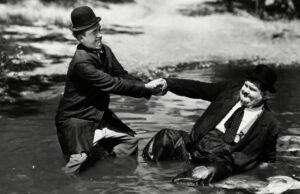
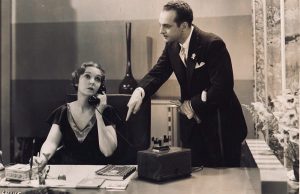
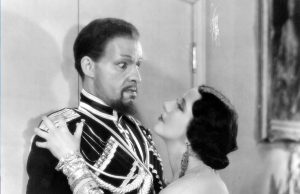






Leave a Reply